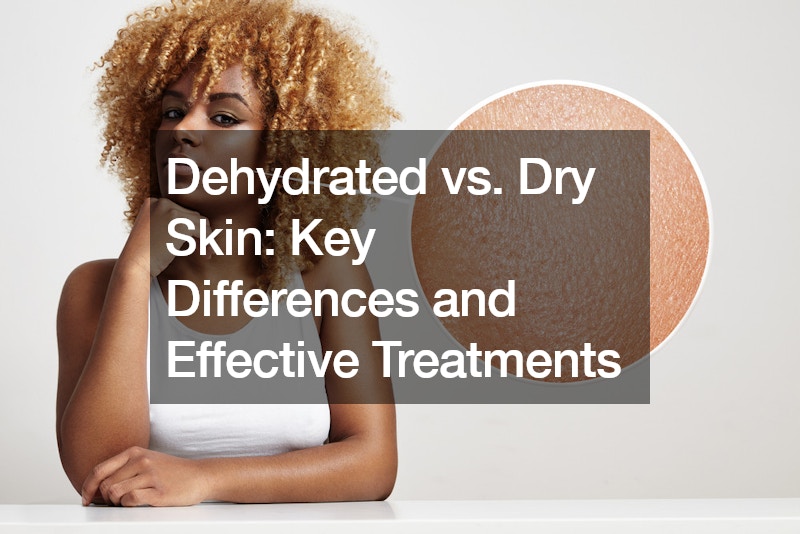Understanding the differences between dehydrated and dry skin is crucial for choosing the right skincare treatments and products. While the terms are often used interchangeably, they refer to distinct skin concerns that require different approaches for effective management. This guide will help you identify whether you have dehydrated or dry skin and explore the most effective treatments for each condition.
What’s the Difference Between Dehydrated Skin and Dry Skin?
Dehydrated Skin
Dehydrated skin is a temporary condition that results from a lack of water in the skin. It can affect any skin type, including oily or combination skin.
Common signs of dehydrated skin include:
- Tightness: Skin feels tight or uncomfortable, especially after cleansing.
- Dullness: The skin appears lackluster and lacks radiance.
- Fine Lines: Temporary fine lines or wrinkles may become more prominent, especially when the skin is not properly hydrated.
- Increased Sensitivity: The skin may feel more sensitive to products or environmental changes.
Dry Skin
Dry skin, on the other hand, is a skin type that results from a lack of natural oils, or sebum, which keeps the skin moisturized and protected. It is often a chronic condition and can be identified by:
- Flakiness: Skin may appear flaky, scaly, or rough.
- Itchiness: There is a persistent itchiness due to the lack of moisture.
- Redness: Skin may look red or inflamed, especially in extreme conditions.
- Cracks or Peeling: Severe dryness can lead to visible cracks or peeling.
Understanding these differences can help you tailor your skincare routine to address your specific skin needs.
Effective Treatments for Dehydrated Skin
To combat dehydrated skin, the focus should be on increasing hydration levels and restoring water balance. Here are some effective treatments:
Hydrating Serums
Look for serums containing hyaluronic acid, glycerin, or aloe vera. Hyaluronic acid attracts and holds water in the skin, while glycerin helps to draw moisture from the environment.
Moisturizers with Humectants
Choose moisturizers with humectants such as hyaluronic acid, glycerin, or urea. These ingredients help to pull water into the skin and keep it there.
Hydrating Masks
Incorporate hydrating masks into your skincare routine. Masks with ingredients like hyaluronic acid, aloe vera, and honey can provide an intense hydration boost.
Proper Hydration
Drinking plenty of water throughout the day supports overall skin hydration. Aim for at least 8 glasses of water a day.
Gentle Cleansers
Use a gentle, hydrating cleanser that does not strip the skin of its natural moisture. Avoid cleansers with harsh sulfates or alcohol.
Effective Treatments for Dry Skin
For dry skin, the focus is on replenishing the skin’s natural oils and creating a barrier to prevent moisture loss. Here are some effective treatments:
Rich Moisturizers
Use moisturizers with emollients such as ceramides, shea butter, or squalane. These ingredients help to lock in moisture and repair the skin barrier. Consider adding a cream for collagen vibrancy to your routine, as these products can also help to restore skin elasticity and improve overall skin texture.
Ointments and Balms
For severely dry skin, consider using heavier ointments or balms. These products are more occlusive and can provide longer-lasting moisture.
Exfoliation
Regular exfoliation helps remove dead skin cells and allows moisturizers to penetrate more effectively. Opt for gentle exfoliants like lactic acid or mild scrubs.
Avoid Hot Water
Hot water can strip away natural oils from the skin, worsening dryness. Use lukewarm water for washing and bathing.
Humidifiers
Using a humidifier in your home adds moisture to the air, which can help prevent skin from becoming too dry.
Common Ingredients for Both Conditions
Some ingredients are beneficial for both dehydrated and dry skin:
- Hyaluronic Acid: A powerful hydrating agent that draws moisture into the skin.
- Glycerin: A humectant that helps maintain hydration.
- Ceramides: Lipids that help restore and maintain the skin’s natural barrier.
- Aloe Vera: A soothing ingredient that hydrates and calms the skin.
How to Choose the Right Products
When selecting skincare products, consider your skin’s specific needs. For dehydrated skin, focus on hydrating products and look for ingredients that boost water content. Opt for lightweight, water-based products. If you have dry skin, on the other hand, choose rich, moisturizing products that restore oils and strengthen the skin barrier. Go for creamy, oil-based products.
Building a Balanced Skincare Routine
A well-rounded skincare routine can address both dehydrated and dry skin concerns. Here’s a basic routine structure:
- Cleansing: Use a gentle, hydrating cleanser for dehydrated skin and a creamy, nourishing cleanser for dry skin.
- Toning: Apply a hydrating toner for dehydrated skin or a soothing toner for dry skin.
- Treatment: Use serums and treatments based on your skin’s primary issue—hydration for dehydrated skin and moisture for dry skin.
- Moisturizing: Apply a moisturizer that suits your skin to lock in hydration and prevent water loss.
- Sunscreen: Don’t forget to use a broad-spectrum sunscreen to protect your skin from UV damage, which can aggravate both conditions.
By recognizing the key differences between dehydrated and dry skin and implementing targeted treatments, you can effectively manage your skin’s health and achieve a glowing, hydrated complexion.
Closing Thoughts
Understanding the distinction between dehydrated and dry skin is the first step towards effective treatment. While dehydrated skin lacks water and can be temporary, dry skin lacks oils and is often a long-term condition. Use the right products and adopt a thoughtful skincare routine to address both issues and maintain healthy, hydrated skin.
.





